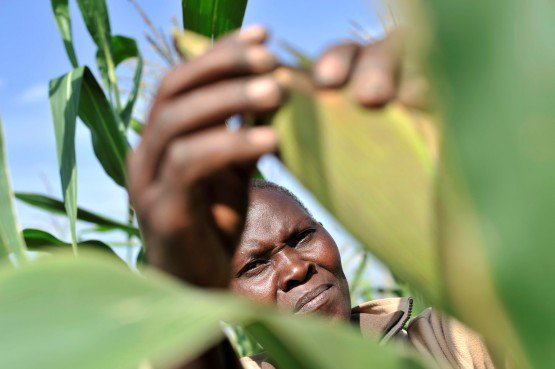After southern Africa’s worst drought in more than 35 years ravaged crops and sent food prices soaring, farmers are battling a new crisis: alien armyworms. 
Godwin Mukenani Mwiya first noticed caterpillars chewing through his corn field south of Lusaka, Zambia’s capital, near the end of December. Two weeks later, he’d lost half his crop to the pest that’s already invaded more than 10 percent of farms in the country and spread to Zimbabwe and Malawi.

Godwin Mukenani Mwiya
The fall armyworm that’s native to the Americas has arrived in southern Africa for the first time, wiping out tens of thousands of acres of corn fields. For a region trying to recover from drought, the pest brings renewed fears of food shortages and inflation. The United Nations’ Food and Agriculture Organization says the effects could be devastating for the area if its spread isn’t controlled.
“It’s really a national disaster because as you can see, half of my crop is gone,” Mwiya, a 56-year-old retired teacher who’s been farming for a decade, said as he scanned his ravaged field. “This has hit me below the belt.”
About 32 million people in the region with a population of 236 million will be food insecure from June 2016 to March this year, the Regional Interagency Standing Committee for southern Africa, which includes the United Nations, said in a report. Prices for white corn, a staple, are about 50 percent above the five-year average in July, it said.
The brown caterpillars, which cost Brazil $600 million a year to control, were first reported in west and central Africa at the start of 2016. They’ve since jumped the equator into Burundi, Zambia, Zimbabwe and Malawi. The spread has been more rapid than expected, according to Georg Goergen, an entomologist who’s studied their arrival and migration on the continent at the International Institute of Tropical Agriculture in Ibadan, about 115 kilometers (72 miles) northeast of Lagos in Nigeria.
Cannibal Caterpillars
“If not controlled in the countries affected, it will have devastating effects not only in those countries, but neighboring countries too, because the spread capacity of this pest is very high,” said David Phiri, who co-ordinates the FAO’s operations in southern Africa, where corn is a staple food.

A fall armyworm, right.
African armyworms, a close relative, are common on the continent. Malawi fought off an invasion a year ago, while an outbreak in late 2012 contributed to an 11 percent reduction in Zambia’s corn production the following year. The fall armyworm grows to a similar size of about 4 centimeters (1.6 inches). Besides preying on crops, fall armyworms can become cannibalistic, eating competitors such as the African variety, according to a study by scientists including Goergen published in October.
How did the pest arrive in Africa? The answer isn’t yet clear, though Goergen says there is evidence that there were at least two separate introductions. One of the theories he’s investigating is that the moths flew over the Atlantic ocean. That would mean a journey of at least 3,000 kilometers between the closest points of South America and Africa.
“Among the speculations, climate change-induced variations in high-altitude wind streams may have favored the shift from one continent to another,” he said in reply to e-mailed questions.
Provinces Invaded
Regardless of how the pests got to the continent, their destructive capacity is clear for growers like Mwiya. His farm is part of the more than 10 percent of Zambia’s cultivated land that’s so far been attacked.
In Zimbabwe, the caterpillars had already invaded seven of the eight provinces where corn is grown. It’s yet to be detected in South Africa, the continent’s biggest producer of the grain, with the government raising an alert and preparing contingency plans in case of an outbreak, said Jan Hendrik Venter at the Department of Agriculture, Forestry and Fisheries’ Plant Health Early Warnings unit.
Zimbabwe and Zambia are trying to contain the outbreak, with the latter declaring it a national crisis and deploying the air force to help distribute pesticide.
“There is no doubt that the introduction of this new pest will have lasting consequences for the farmer and food security in tropical Africa,” said Goergen. “There is definitively an urgent need to develop local solutions building on the experience in the Western Hemisphere and adapting them.”-Bloomberg






